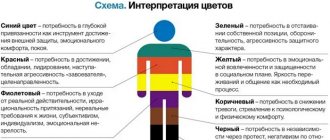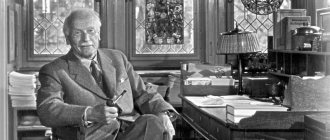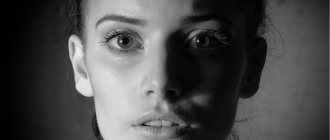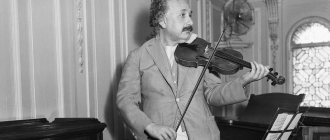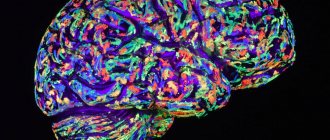Greetings, dear readers!
A person’s behavior, his facial expressions, manners and gestures can tell much more about him than he himself. Even if your interlocutor has absolutely nothing to hide, the ability to see such signals will help you better understand him. A professional psychologist, using these subtle signals, can create a detailed psychological portrait of a person, but some things are also available to ordinary people. Today we will figure out what a psychological portrait is and how to draw it up for a friend or for yourself. Let's begin.
What is it and what is it for?
A psychological portrait is a verbal written interpretation of a personality.
This characteristic allows you to get a general idea of a person’s individual qualities and predict his behavior.
This psychological technique is actively used in professional activities , as well as for personal purposes.
Recruitment specialists analyze the abilities of job applicants, teachers, in order to successfully organize the educational process, draw up psychological portraits of the class, managers identify the personal qualities of subordinates, etc.
Each person can independently try to create a description of his personality or study someone from his environment.
Of course, to obtain the most reliable results, you should contact specialists. The professional psychological portrait of a psychologist will fully reflect all the individual characteristics of the subject.
Having information about key personality qualities, you can determine the most suitable type of activity, level of self-esteem, degree of openness to communication, determination, etc.
Key elements
The psychological portrait includes a description of the following personality traits:
- Temperament . It is customary to divide people into sanguine, choleric, melancholic and phlegmatic. Usually, temperaments are rare in their pure form; more often, two similar types are combined in a person. Choleric people are active and purposeful, melancholic people are sensitive and vulnerable, sanguine people are extremely friendly and sociable, and phlegmatic people are reliable and calm. Depending on the rhythm of mental processes, people participate in activities, behave in relationships and enter into communication differently. Temperament is an innate, not an acquired quality. That is, a phlegmatic person will never become a choleric person, regardless of the degree of influence of external circumstances. Only some adjustment of the initial data is possible.
- Character. This personality trait is also manifested in the presence of stable behavioral traits. But character is formed to a greater extent as one grows up under the influence of life circumstances and upbringing.
And although its basis is made up of traits inherited from previous generations, they are largely supplemented by acquired moral and moral attitudes.Thus, children from the same parents who end up in different foster families may grow up completely different from each other due to differences in upbringing and living conditions. A person's character can be described both from a positive and negative side. For example, an individual can be kind, open, sociable, sympathetic and at the same time lazy, cowardly, and touchy.
- Capabilities . Usually abilities are divided into spiritual, physical and social. Primary are physical abilities - level of health, endurance, skills and achievements. Spiritual development occurs as one receives education and assimilates moral and cultural norms. Social skills develop through education. This is the ability to communicate, openness, discipline, responsibility, punctuality, etc.
- Intelligence .
A certain level of intelligence is inherent in a person from birth. History knows many cases when great geniuses appeared in absolutely ordinary families with undistinguished parents. Each individual has the opportunity to develop their intellectual abilities by acquiring new knowledge and practical experience, but initial natural data still plays an important role. Gifted, talented or brilliant people discover their abilities in a certain area at an early age. - Emotions . The emotionality of a person is expressed in the ability to reflect their experiences and moods. Depending on the degree of emotionality, an individual perceives the surrounding reality in a certain way and forms a response. Emotions help people understand each other better. Correctly assessing the state of your interlocutor makes it possible to adapt to his mood. Even with language, cultural or intellectual barriers, people always recognize the emotions of joy, sadness, fear, anger, etc. in the same way.
- Will . It is the developed volitional qualities that form the core of character and allow a person to achieve success in life. Purposefulness, self-control, determination and independence are all characteristics of a strong and self-sufficient personality. Even with favorable living conditions and the presence of outstanding intellectual abilities, a weak-willed individual will not be able to achieve significant results. Due to laziness, lack of initiative and lack of self-discipline, he will constantly miss out on favorable opportunities.
- Communication skills .
Any person, regardless of his age, social status and level of development, should be able to find a common language with others. People's communication abilities are developed to varying degrees. Not only natural data, but also acquired skills are of great importance. For example, a psychological portrait of a manager is guaranteed to contain information about the high level of development of the subject’s communication abilities. An employee’s professional activity is based on communication with people, and without communication skills it is impossible to achieve results in this area. - Self-control . This quality directly depends on the degree of development of volitional abilities. When hiring specialists who will perform their duties under stressful conditions, the level of self-control is one of the key characteristics.
- Self-esteem . This is the degree of confidence in yourself and your abilities. It is usually customary to talk about normal, low and high self-esteem. In the first case, a person evaluates himself most objectively. With low self-esteem, there is a lack of self-confidence and excessive self-criticism, and with high self-esteem, there is an overestimation of one’s own capabilities and achievements.
- Motivation .
An internal emotional state that motivates a person to action. The motive may be to obtain the desired position, material gain, position in society, the favor of significant people, etc.
Characteristics of a friend
Every person has a friend. Friends can be close and real. I also have a close friend whose name is Vitya. My friend will soon be 13 years old. We have been friends with him for a long time, and he has never let me down.
Vitya is in 8th grade, just like me. He is very sociable, so it is very easy to talk to him and find a topic for conversation. He very quickly finds topics for conversation and tries in every possible way to prolong it. It is very difficult to stop him in the midst of a conversation, but I did not have to do this, since communicating with him brings benefits and pleasure.
Another trait of his character is responsibility. A responsible approach to business and compliance with the rules is all about him. There were probably no cases that he would have treated irresponsibly. So his mother will ask him to go to the store for bread and give him money, so he will buy what he needs and not spend the day on something else. Even when we walk in the yard, he always tries not to stay late and advises me to do this.
Vitya is also a very creative person. He has a lot of interesting ideas in his head. While we are walking, he can come up with many different ideas for games. He will gladly help his mother figure out something to do with her little sister.
It’s not for nothing that they say that a friend is a friend in need. This is how my friend will not leave me or his other friends in trouble. He will always come to the rescue. Even in the situation when my cat disappeared, when he learned about it, he came to my house and offered his help. He helped me put up advertisements and look for my cat.
Vitya loves sports very much. Every evening he goes for a long walk with his parents. Then they visit the sports ground. He knows how and loves to jump rope. But he loves to play ball. Together with their parents and neighbors, they built a small football field where children now play.
But along with these traits, he also has some negative ones. One of these is his sloppiness. He always comes home from parties with dirty clothes. But maybe football players can’t do otherwise and in the future he will become a real football player?
Thus, my friend Vitya has many good qualities. What I like about him is his responsibility and the fact that he won’t leave me in trouble. Here I can say with confidence that Vitya is my best friend.
How to compose?
How to create a psycho-portrait of me or someone else?
It is advisable to contact specialists , but it is also realistic to cope with the task on your own. The object of study can be one’s own person or another person about whom it is necessary to obtain comprehensive information.
Popular questionnaires will help you correctly leave a psychological portrait :
- J. Rotter test;
- questionnaire L.N. Sobchik;
- R. Cattell's test;
- Leonhard characterological questionnaire.
In addition to questionnaires, other personality assessment methods are also used.
So, you can create a psychological portrait from a drawing, analyze handwriting, conduct a test for non-verbal communication, solve logical riddles, etc.
The simplest research option is to analyze the properties of an object. In this case, it is enough to give a step-by-step description of the ten key personality traits listed above on a piece of paper.
In this case, the objectivity of the assessment is of great importance. It is not always possible for a person to evaluate himself or someone around him as impartially as possible.
Building your psychological portrait will help you understand your own personality, decide on the appropriate type of professional activity, and objectively evaluate the people around you.
Essay Characteristics of a Friend
Each person has his own character, his own facial features, features of facial expressions and gestures that make him unique and attractive to others. There was a new girl in my class two years ago. She immediately attracted my attention with her special appearance. She was placed at my desk, and from then on we became inseparable friends. That's why I would like to talk about it.
Her name is Lena. She is short, shorter than me, and very thin and slender. She has very thin and graceful arms and legs. She has medium facial features, a very beautiful shade of brown eyes and semicircular eyebrows. Her nose is neat and straight. The lips are thin, evenly outlined by nature itself. Her skin is dark and I find it attractive. But the most eye-catching thing about her is the huge head of tightly curly dark curls that she has been struggling with since we met. They are unruly, always get out of their hair and do not respond to any straighteners. Somehow she manages to straighten her bangs, but it doesn’t last long: if the humidity on the street increases even a little (for example, it rains), then the curls reach her forehead. I think she’s beautiful, but, unfortunately, she has a completely different opinion about herself...
At first, Lena was very modest in class, among her peers and in lessons. But then she got used to it, and it became much more fun to spend time with her! Among her good acquaintances and friends, she is very cheerful, mischievous and cheerful. You can safely trust her with secrets, because she knows how not to say too much and does not betray.
She is active in class, especially if she is well versed in the topic. She loves to study, many topics are interesting to her, but she does not try to be an excellent student - a “good” grade completely suits her. At the same time, Lena is not averse to sometimes “being clever” or correcting someone if they made a mistake in speech or put the wrong emphasis on a word.
My friend likes to read all kinds of psychological literature, watch anime cartoons and dreams of becoming a translator, so she devotes her free time to studying English and Japanese (she does this from films, music, and grammar books). I don’t think it’s possible to progress very far in languages if you don’t study with a tutor, but I try to support her because it’s important to her.
I think all friends should do this, don't they?
Plan
When compiling a person’s profile, you should adhere to the standard plan:
- Individual data. Age, gender, health status, physical parameters.
- Social data . Marital status, profession, education.
- Short biography. Here a person describes important moments in his life that had a significant impact on him (relationships with parents, shocks and conflicts, etc.).
- Individual characteristics . 10 key personality traits are analyzed.
- Conclusions . A forecast is made for the further development of the individual, problems are identified and ways to solve them are determined.
Psychological portrait of a personality: a ready-made writing sample.
An example of a description of a famous person
World historiography contains a large amount of information about various famous people.
Their psychological portraits are of particular interest.
Analysis of the individual characteristics of historical figures is carried out on the basis of the study of written testimonies of contemporaries, personal diaries of the people themselves.
With the help of physiognomy (analysis of character traits based on facial features), a psychological portrait is even drawn up from a photo.
Of great interest is the personality of Napoleon Bonaparte . His psychological portrait, compiled according to the above plan, looks like this:
- Man born in 1769 . Height - 169 cm. He suffered from epileptic seizures.
- Emperor of France , commander and statesman. Was married twice.
- Since childhood, he showed a love of reading . He experienced problems communicating with peers, because of whose bullying he was forced to spend most of his time in solitude. From an early age he showed interest in military affairs.
- Hot-tempered, purposeful, merciless, efficient, disciplined, selfish. He processed information and made decisions with lightning speed. He was an excellent tactician and strategist . Didn't like talking to people. Demonstrated a contemptuous attitude towards others. He easily fell into a state of anger, often developing into fits. Despite the presence of many internal contradictions, he outwardly tried to give the impression of a confident person. The main motive of activity is the thirst for power.
- An influential position in society and the presence of great power aggravated negative character traits that arose at an early age. Internal self-doubt gave rise to anger and contempt for others.
The face is a social tool
Researchers have proven that the human brain recognizes the face as a whole, and not in the aggregate of individual parts of an individual’s face. Peter Thompson demonstrated this with a photograph of Margaret Thatcher. An upside-down photo, but with unchanged eyes and lips, at first glance, was not noticed by anyone.
The face is an informative, adaptive, social tool about a person’s psychotype and character, even about his behavioral stereotypes.
A portrait of a personality is read on an unconscious intuitive level. We have a certain experience of socialization, and even in childhood, school and in other institutions we have learned to expect identical actions and behavior from people with similar traits.
Behavioral portrait
Behavioral portrait - what does it mean?
This is a psychological characteristic of human behavior that he demonstrates in different life situations.
Such information can be obtained as a result of observing the object, as well as through a conversation with the person himself and his close people.
The behavioral portrait includes the following information:
- appearance;
- pantomime;
- facial expressions;
- speech;
- attitude towards others;
- attitude towards oneself;
- behavior during main activities;
- reaction to conflicts.
Correction methods
In order to influence the mental, practical activity of the individual, psychologists are constantly developing new techniques. Psychocorrection methods:
- Auto-trainings are trainings that use three ways to influence the functioning of the nervous system. The first is that in order for the subject to relax the muscles of the body, he must learn to control the rhythm of breathing. The second method is the presentation of sensory images. The third way is to pronounce programming words mentally or out loud.
- Group trainings. Their goal is to develop personal relationships between people and assist in communication.
Each method consists of several practices that have the same goal, but are carried out differently.
A psychological profile of a person is compiled to obtain an idea of a person, his capabilities, talents, and inclinations. Only an experienced psychologist can draw up a portrait using certain techniques.
